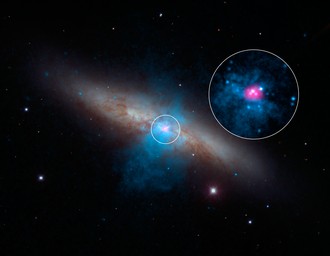
Ultraluminous X–ray sources (ULXs) have apparent luminosities above 1039 erg/s, which corresponds to the Eddington limit for a standard 10 solar-mass accretor, but are not in the nuclei of their host galaxies. Because of this defining properties it was believed for some time that ULXs contain so-called Intermediate-Mass Black Holes with masses between 100 and 10 000 solar masses. However, there has been growing evidence that ULXs are standard X–ray binaries in unusual and short-lived phases of their secular evolution, but many authors have assumed that the accretor in such systems is always a black hole. But recently Bachetti et al. (2014) discovered, with the satellite NuSTAR, that the ULX X–2 in the galaxy M82, with luminosity about 100 times Eddington, contains an X-ray pulsar with a period of 1.37 second, i.e. an accreting, spinning, magnetic neutron star. Andrew King, from the University of Leicester, and Jean-Pierre Lasota from the Copernicus Astronomical Center and Institut d'Astrophysique de Paris (King & Lasota 2016), show that this system fits naturally into the simple picture of ULXs as beamed X–ray sources fed at super–Eddington rates, provided that its magnetic field is weaker (~1011 Gauss) than a new–born X–ray pulsar, as expected if there has been a mass gain. Continuing accretion is likely to weaken the field to the point that pulsing stops, and make the system indistinguishable from a ULX containing a black hole. King & Lasota suggest that a significant fraction of all ULXs may actually contain neutron star accretors rather than black holes, reflecting the neutron–star fraction among their X–ray binary progenitors. The model predicts that the nearest suitably oriented system of this type is at a distance ~ 5.6 Mpc. M82 is at 4 Mpc, which, considering the uncertainties, is in very satisfactory agreement with the model prediction.
King, Andrew, & Lasota, Jean-Pierre, 2016, ULXs: Neutron Stars vs Black Holes, MNRAS, in press, arXiv:1601.03738
Bachetti et al., 2014, An ultraluminous X-ray source powered by an accreting neutron star, Nature, 514, 202
Picture: Ultraluminous galaxy M82.






